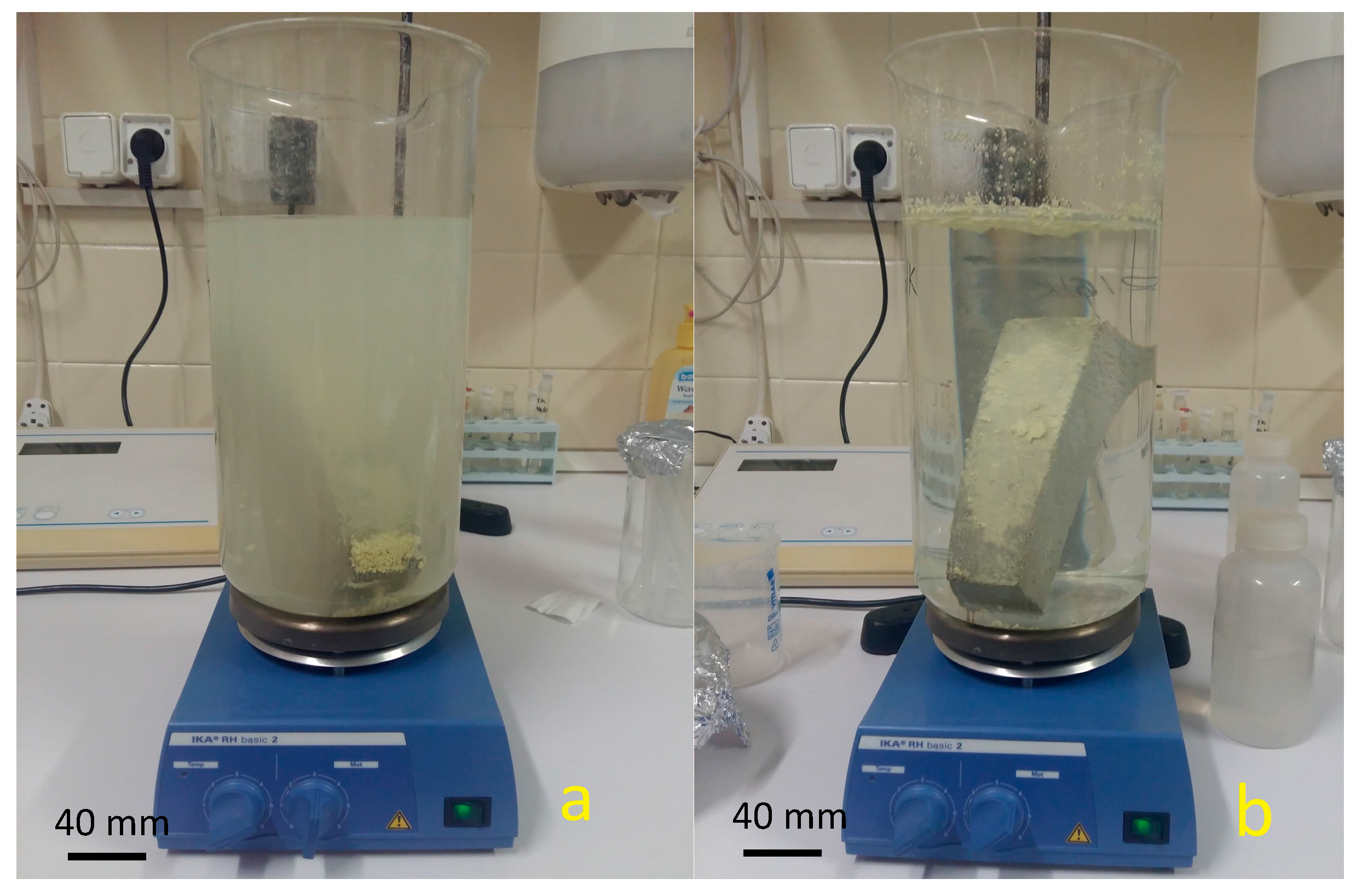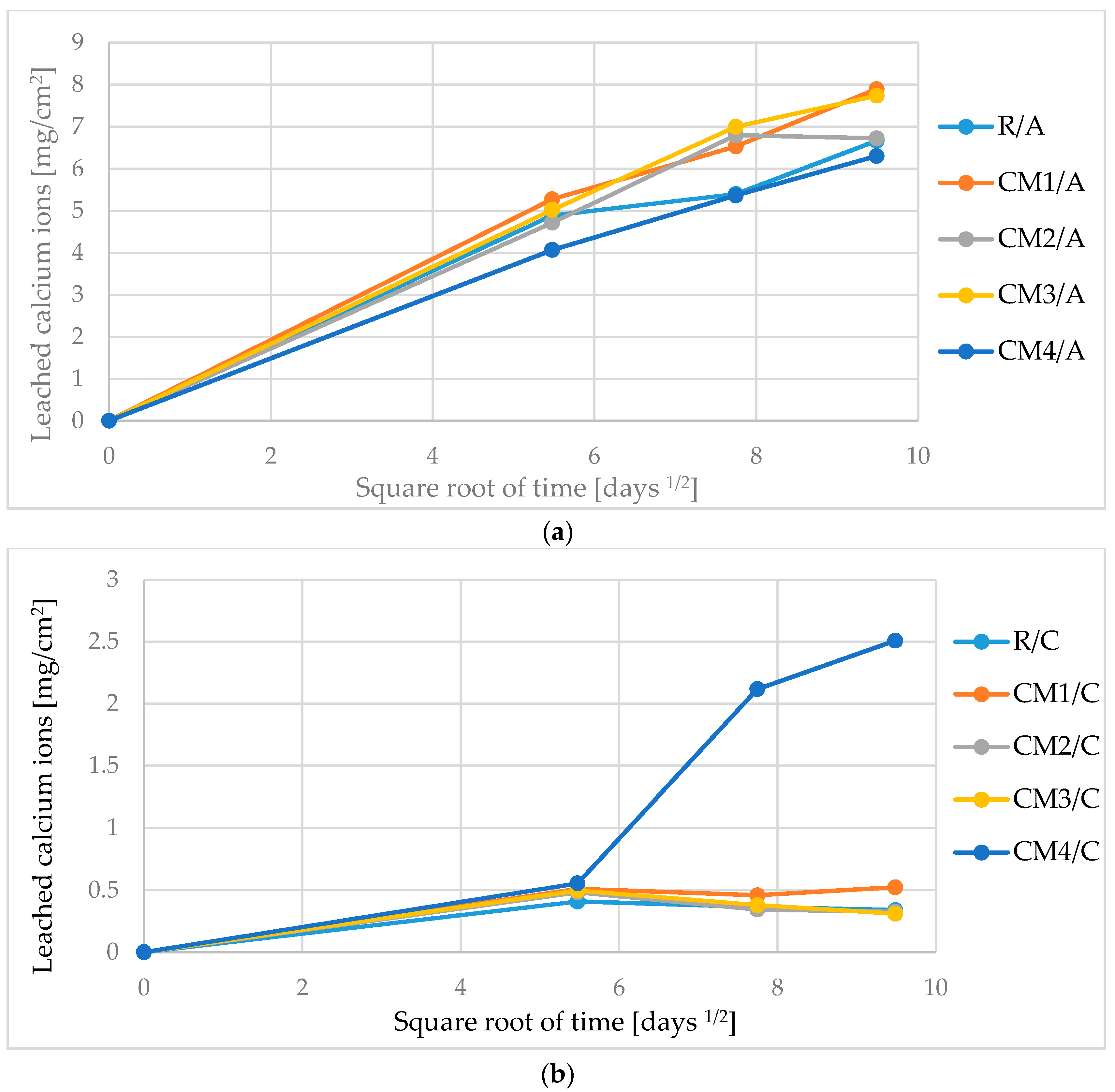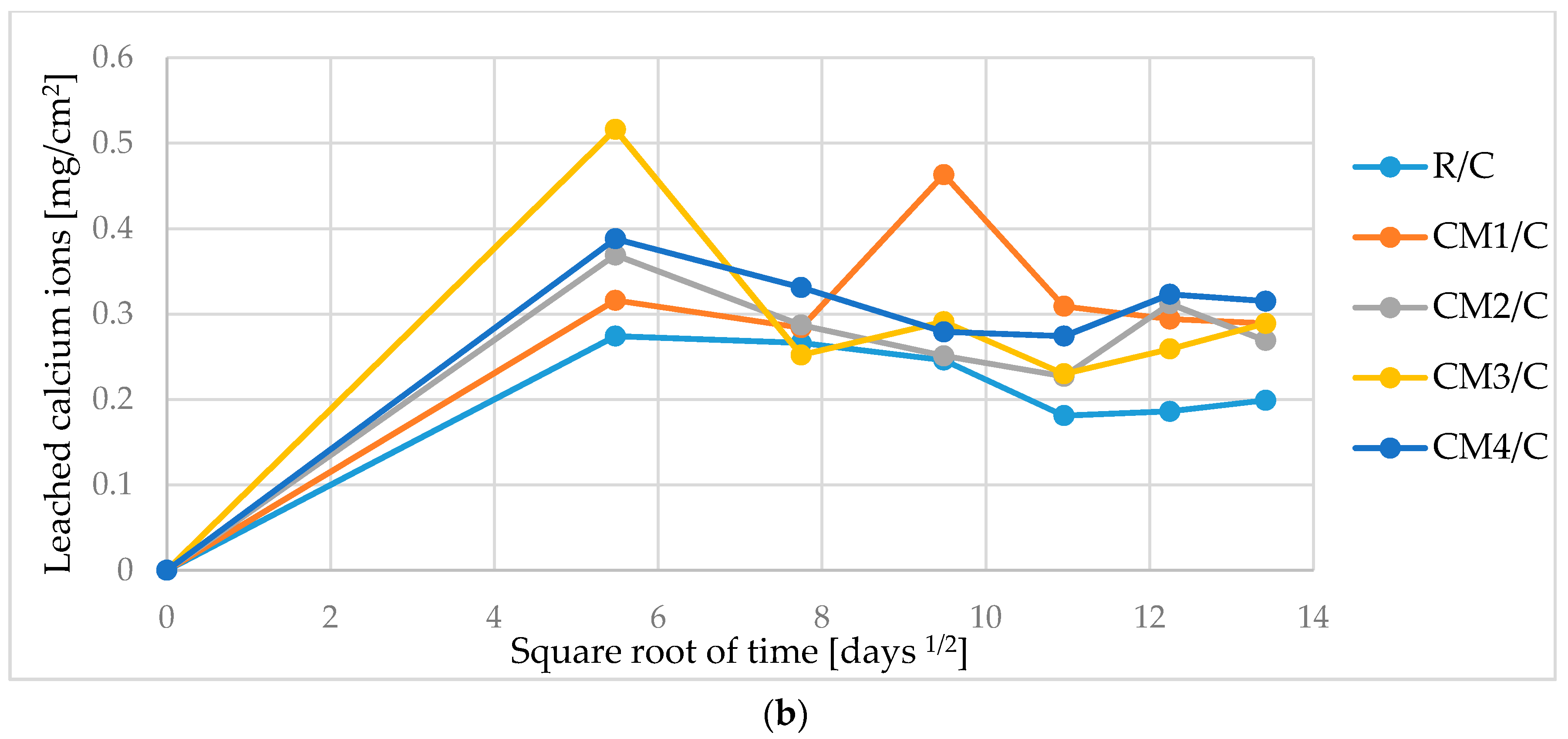Calcium Extraction from Blast-Furnace-Slag-Based Mortars in Sulphate Bacterial Medium
Abstract
:1. Introduction
2. Materials and Methods
2.1. Cement Mortar Mixtures
2.2. Bacterial Solution
2.3. Measuring the Extraction of Calcium from the Mortars
2.4. Damaged Depth Calculation
3. Results and Discussion
3.1. Leaching Trends of Calcium Ions
3.2. Durabilty of Mortars in Terms of the Leached Quantities of Calcium Ions
3.3. Damaged Depths of Mortars
4. Conclusions
- Samples exposed to the medium with sulphur-oxidising bacteria A. thiooxidans had proven higher calcium leaching rates and significantly deeper degradation than the samples exposed to the nutrient medium without bacteria.
- The blast furnace slag modified paste did not show definitely lower values in calculated damaged depths, comparing to the reference one.
- When evaluating the calculated damaged depths of blast furnace slag-based mortars, the sample with 75 wt % of blast furnace slag was found out to be the most resistant in A. thiooxidans bacterial environment. The assumption of the best performance of the sample with the highest proportion of blast furnace slag was not confirmed.
Acknowledgments
Author Contributions
Conflicts of Interest
References
- Fernando, W.A.M.; Ilankoon, I.M.S.K.; Syed, T.H.; Yellishetty, M. Challenges and opportunities in the removal of sulphate ions in contaminated mine water: A review. Miner. Eng. 2018, 117, 74–90. [Google Scholar] [CrossRef]
- Tang, Y.J.; Zuo, X.B.; He, S.L.; Ayinde, O.; Yin, G.J. Influence of slag content and water-binder ratio on leaching behavior of cement pastes. Constr. Build. Mater. 2016, 129, 61–69. [Google Scholar] [CrossRef]
- Kong, L.; Zhang, B.; Fang, J. Study on the applicability of bactericides to prevent concrete microbial corrosion. Constr. Build. Mater. 2017, 149, 1–8. [Google Scholar] [CrossRef]
- Vupputuri, S.; Fathepure, B.Z.; Wilber, G.G.; Sudoi, E.; Nasrazadani, S.; Ley, M.T.; Ramsey, J.D. Isolation of a sulfur-oxidizing Streptomyces sp. from deteriorating bridge structures and its role in concrete deterioration. Int. Biodeterior. Biodegrad. 2015, 97, 128–134. [Google Scholar] [CrossRef]
- Václavík, V.; Ondrašiková, I.; Dvorský, T.; Černochová, K. Leachate from Municipal Waste Landfill and Its Natural Degradation—A Case Study of Zubří, Zlín Region. Int. J. Environ. Res. Pubic Health 2016, 13, 873. [Google Scholar] [CrossRef] [PubMed]
- Gola, L.; Václavík, V.; Valíček, J.; Harničárová, M.; Kušnerová, M.; Dvorský, T. Drainage concrete based on cement composite and industrial waste. Adv. Struct. Mater. 2015, 70, 155–165. [Google Scholar] [CrossRef]
- Parker, C.D. The function of Thiobacillus Concretivorus (Nov. Spec.) in the corrosion of concrete exposed to atmospheres containing hydrogen sulphide. Aust. J. Exp. Biol. Med. Sci. 1945, 23, 91–98. [Google Scholar] [CrossRef]
- Noeiaghaei, T.; Mukherjee, A.; Dhami, N.; Chae, S.R. Biogenic deterioration of concrete and its mitigation technologies. Constr. Build. Mater. 2017, 149, 575–586. [Google Scholar] [CrossRef]
- Whittaker, M.; Black, L. Current knowledge of external sulphate attack. Adv. Cem. Res. 2015, 27, 532–545. [Google Scholar] [CrossRef]
- Whittaker, M.; Zajac, M.; Haha, M.B.; Black, L. The impact of alumina availability on sulfate resistance of slag composite cements. Constr. Build. Mater. 2016, 119, 356–369. [Google Scholar] [CrossRef]
- Jain, J.; Neithalath, N. Analysis of calcium leaching behavior of plain and modified cement pastes in pure water. Cem. Concr. Compos. 2009, 31, 176–185. [Google Scholar] [CrossRef]
- Mainguy, M.; Tognazzi, C.; Torrenti, J.M.; Adenot, F. Modeling of leaching in pure cement paste and mortar. Cem. Concr. Res. 2000, 30, 83–90. [Google Scholar] [CrossRef]
- Kamali, S.; Moranville, M.; Leclercq, S. Material and environmental parameter effects on the leaching of cement pastes: Experiments and modeling. Cem. Concr. Res. 2008, 38, 575–585. [Google Scholar] [CrossRef]
- Muynck, W.D.; Belle, N.D.; Verstraete, W. Effectiveness of admixtures, surface treatments and antimicrobial compounds against biogenic sulfuric acid corrosion of concrete. Cem. Concr. Compos. 2009, 31, 163–170. [Google Scholar] [CrossRef]
- Berndt, M.L. Evaluation of coatings, mortars and mix design for protection of concrete against sulphur oxidising bacteria. Constr. Build. Mater. 2011, 25, 3893–3902. [Google Scholar] [CrossRef]
- Stevulova, N.; Vaclavik, V.; Junak, J.; Grul, R.; Bacikova, M. Utilization possibilities of selected waste kinds in building materials preparing. In Proceedings of the 8th International Scientific Conference (SGEM 2008), Sofia, Bulgaria, 16–20 June 2008. [Google Scholar]
- Higgins, D.D. Increased sulfate resistance of GGBS concrete in the presence of carbonate. Cem. Concr. Compos. 2003, 25, 913–919. [Google Scholar] [CrossRef]
- Ogawa, S.; Nozaki, T.; Yamada, K.; Hirao, H.; Hooton, R.D. Improvement on sulfate resistance of blended cement with high alumina slag. Cem. Concr. Res. 2012, 42, 244–251. [Google Scholar] [CrossRef]
- Hooton, R.D.; Emery, J.J. Sulfate resistance of a Canadian slag cement. ACI Mater. J. 1990, 87, 547–555. [Google Scholar] [CrossRef]
- Slovak Office of Standards, Metrology and Testing. STN 73 1316: Determination of Moisture Content, Absorptivity and Capillarity of Concrete; Slovak Office of Standards, Metrology and Testing: Bratislava, Slovakia, 1989. (In Czech) [Google Scholar]
- Waksman, S.A.; Joffe, J.S. Microörganisms Concerned in the Oxidation of Sulfur in the Soil: II. Thiobacillus Thiooxidans, a New Sulfur-oxidizing Organism Isolated from the Soil 1. J. Bacterial. 1922, 7, 239–256. [Google Scholar] [CrossRef]
- Kovalcikova, M.; Estokova, A.; Luptakova, A. Application of granulated blast furnace slag in cement composites exposed to biogenic acid attack. Mater. Sci. Eng. 2015, 96, 1–8. [Google Scholar] [CrossRef]
- Estokova, A.; Smolakova, M.; Luptakova, A. A contribution to sustainable structures by using waste in concrete materials for improving their durability. In Proceedings of the 41st IAHS World Congress Sustainability and Innovation for the Future, Albufeira, Portugal, 13–16 September 2016. [Google Scholar]
- Strigac, J.; Martauz, P.; Estokova, A.; Stevulova, N.; Luptakova, A. Bio-corrosion resistance of concrete containing antimicrobial ground glanulated blast furnace slag Biolanova and novel hybrid H-cement. Solid State Phenom. 2016, 244, 57–64. [Google Scholar] [CrossRef]
- Kovalčíková, M.; Eštoková, A. Leaching of calcium and silicon from cement composites in the aggressive environment. Pollack Period. 2014, 9, 123–130. [Google Scholar] [CrossRef]
- Rozière, E.; Loukili, A.; El Hachem, R.; Grondin, F. Durability of concrete exposed to leaching and external sulphate attacks. Cem. Concr. Res. 2009, 39, 1188–1198. [Google Scholar] [CrossRef]
- Kovalčíková, M.; Eštoková, A.; Oravec, J.; Luptáková, A. Investigation of the precipitates on the concrete surface due to sulphate exposure. J. Civ. Eng. 2016, 11, 31–38. [Google Scholar] [CrossRef]
- Kuri, J.C. Leaching of cementitious materials: A review. Asian Trans. Eng. 2015, 5, 15–18. [Google Scholar]




| Components | OPC | GBFS | |
|---|---|---|---|
| Chemical composition [% by mass] | Calcium oxide (CaO) | 57.15 | 39.55 |
| Silica (SiO2) | 19.01 | 38.95 | |
| Alumina (Al2O3) | 4.02 | 8.33 | |
| Iron oxide (Fe2O3) | 2.69 | 0.54 | |
| Sulphur trioxide (SO3) | 1.49 | 0.57 | |
| Magnesium oxide (MgO) | 1.37 | 10.11 | |
| Potassium oxide (K2O) | 1.12 | 0.48 | |
| Phosphorus pentoxide (P2O5) | 0.33 | 0.04 | |
| Magnesium oxide (MnO) | - | 0.74 | |
| Titanium dioxide (TiO2) | 0.18 | 0.37 | |
| Clorine (Cl) | 0.06 | 0.02 | |
| Other | 12.58 | 0.30 | |
| Mineralogical composition [% by mass] | Tricalcium silicate (C3S) | 64.10 | - |
| Dicalcium silicate (C2S) | 11.34 | ||
| Tricalcium aluminate (C3A) | 8.18 | ||
| Tetracalcium aluminoferrite (C4AF) | 6.12 | ||
| Gypsum (CSH2) | up to 5 | ||
| Other | 5.26 | ||
| Mortar Sample | Leached Calcium (mg/cm2) | Initial Calcium Content (mg/cm3) | DD (mm) |
|---|---|---|---|
| R/A | 6.66 | 348.22 | 0.19 |
| R/C | 0.34 | 353.86 | 0.01 |
| CM1/A | 7.89 | 254.57 | 0.31 |
| CM1/C | 0.52 | 253.05 | 0.02 |
| CM2/A | 6.72 | 306.24 | 0.22 |
| CM2/C | 0.33 | 307.45 | 0.01 |
| CM3/A | 7.74 | 314.66 | 0.25 |
| CM3/C | 0.31 | 313.15 | 0.01 |
| CM4/A | 6.30 | 193.49 | 0.33 |
| CM4/C | 2.51 | 197.63 | 0.13 |
| Mortar Sample | Leached Calcium (mg/cm2) | Initial Calcium Content (mg/cm3) | DD (mm) |
|---|---|---|---|
| R/A | 8.01 | 350.36 | 0.23 |
| R/C | 0.27 | 357.72 | 0.01 |
| CM1/A | 7.06 | 254.80 | 0.28 |
| CM1/C | 0.29 | 255.03 | 0.01 |
| CM2/A | 5.59 | 304.99 | 0.18 |
| CM2/C | 0.27 | 309.74 | 0.01 |
| CM3/A | 6.73 | 314.56 | 0.21 |
| CM3/C | 0.37 | 315.68 | 0.01 |
| CM4/A | 7.71 | 193.61 | 0.40 |
| CM4/C | 0.39 | 197.84 | 0.02 |
© 2018 by the authors. Licensee MDPI, Basel, Switzerland. This article is an open access article distributed under the terms and conditions of the Creative Commons Attribution (CC BY) license (http://creativecommons.org/licenses/by/4.0/).
Share and Cite
Estokova, A.; Smolakova, M.; Luptakova, A. Calcium Extraction from Blast-Furnace-Slag-Based Mortars in Sulphate Bacterial Medium. Buildings 2018, 8, 9. https://doi.org/10.3390/buildings8010009
Estokova A, Smolakova M, Luptakova A. Calcium Extraction from Blast-Furnace-Slag-Based Mortars in Sulphate Bacterial Medium. Buildings. 2018; 8(1):9. https://doi.org/10.3390/buildings8010009
Chicago/Turabian StyleEstokova, Adriana, Michaela Smolakova, and Alena Luptakova. 2018. "Calcium Extraction from Blast-Furnace-Slag-Based Mortars in Sulphate Bacterial Medium" Buildings 8, no. 1: 9. https://doi.org/10.3390/buildings8010009
APA StyleEstokova, A., Smolakova, M., & Luptakova, A. (2018). Calcium Extraction from Blast-Furnace-Slag-Based Mortars in Sulphate Bacterial Medium. Buildings, 8(1), 9. https://doi.org/10.3390/buildings8010009






